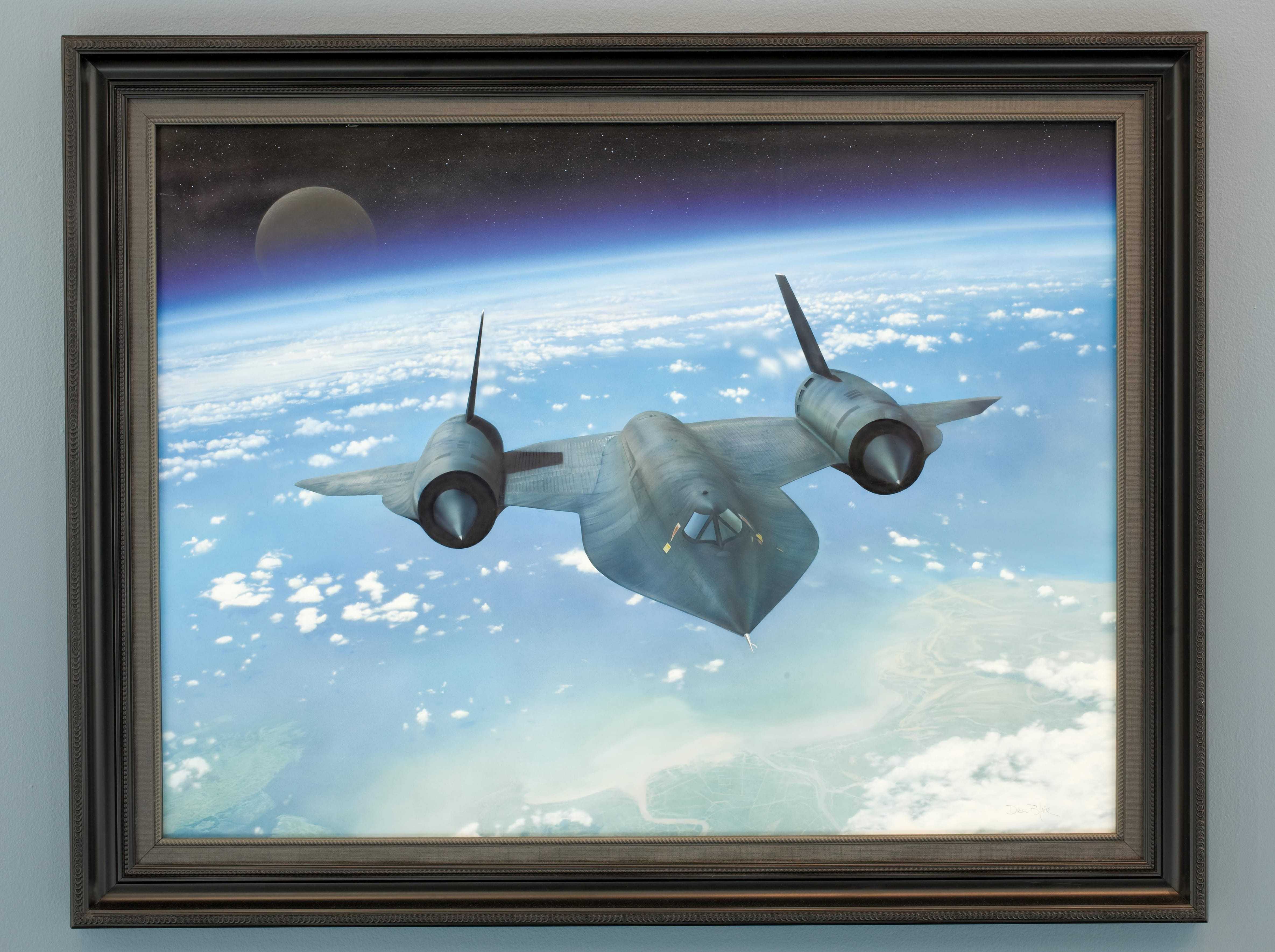Art Details

“Untouchable,” a painting in the CIA Intelligence Art Gallery, depicts the A-12 OXCART aircraft: a revolutionary aircraft that was able to fly at three times the speed of sound for more than 3,000 miles without having to be refueled. The legendary inventor and CIA Trailblazer, Richard Bissell, invented both the U-2 spy plane and it’s successor, the OXCART.
by Dru Blair
Mixed Media on Illustration Board, 2007
Donated by Daniel K. Hilton
Under the highly secret Project OXCART, CIA developed the A-12 as the U-2’s successor, intended to meet our nation’s need for a very fast, very high-flying reconnaissance aircraft that could avoid Soviet air defenses. CIA awarded the OXCART contract to Lockheed (builder of the U-2) in 1959. In meeting the A-12’s extreme speed and altitude requirements, Lockheed led by legendary engineer Clarence “Kelly” Johnson -overcame numerous technical challenges with cutting-edge innovations in titanium fabrication, lubricants, jet engines, fuel, navigation, flight control, electronic countermeasures, radar stealthiness, and pilot life-support systems. In 1965, after hundreds of hours flown at high personal risk by an elite team of CIA and Lockheed pilots, the A-12 was declared fully operational. It subsequently attained a sustained speed of Mach 3.29 (just over 2,200 miles per hour) at 90,000 feet altitude to this day, an unbroken record for piloted jet aircraft.
CIA’s operational use of the A-12 faced not only many technical challenges but also political sensitivity to aircraft flights over denied areas and competition from imaging satellites. After the U-2 piloted by Francis Gary Powers was shot down over the Soviet Union in May 1960, all overflights of the USSR were halted, thus blocking the A-12’s original mission to monitor the Soviet Bloc. By the time of CIA’s first A-12 deployment in 1967, CORONA satellites were being launched regularly to collect thousands of images worldwide each year. Although its imagery was less timely and of poorer resolution than the A-12’s, CORONA was invulnerable to anti-aircraft missiles and much less provocative than A-12 overflights. At the same time, the US Air Force was developing the SR-71, a modified version of the A-12. Seeing little value in maintaining both overt SR-71 and covert A-12 fleets with similar capabilities, President Johnson ordered retirement of the A-12 by 1968.
The only A-12 reconnaissance operation, codenamed BLACK SHIELD, took place from May 1967 to May 1968. A detachment of six pilots and three A-12s based at Kadena Air Base in Okinawa flew 29 missions over East Asia. The panoramic stereo camera aboard each aircraft yielded considerable high-quality imagery that within hours of landing was processed and under the eagle eyes of photointerpreters, who provided valuable intelligence in support of US military operations during the Vietnam War. Also, A-12 imagery of North Korea enabled them to locate the intelligence ship USS Pueblo illegally seized by North Korea and to confirm no further hostilities were imminent.
To commemorate this pioneering and unsurpassed aeronautical achievement, the painting depicts the first BLACK SHEILD reconnaissance flight on 31 May 1967 over North Vietnam. Piloted by Mele Vojvodich, Article 131 took off in a torrential downpour just before 1100 local Okinawa time. The A-12 had never operated in heavy rain before, but weather over the target area was forecast as satisfactory, so the flight went ahead. Vojvodich flew the planned route at 80,000 feet and Mach 3.1, refueled immediately after taking off and during each of two loops over Thailand, and safely touched down at Kadena with a total flight time of three hours and 39 minutes. The intelligence mission was a resounding success: after detailed examination of nearly a mile of film that was collected, photointerpreters found no surface-to-surface missiles that might threaten US and allied military forces in the South and assessed the status of 70 of the 190 known surface-to-air missile sites and nine other priority targets. Contrary to some published accounts, Chinese or North Vietnamese radar did not track the aircraft, nor did North Vietnam fire any missiles at it. The A-12 had proven itself a valuable imagery collector, untouchable by hostile air defenses far below.
Art Specs
87 cm x 111 cm
(H x W)
Video
This video does not include text.
